|
Introducing India - Map
India, the land of great wonders and diversities, is one of the most fascinating tourist spots in the world. India has always impressed its visitors with its exceptionally beautiful natural landscapes, amazing historic monuments and fascinating cultural heritage and whosoever visits this enchanting land, is rewarded with an unforgettable holiday experience.

India's $42 billion travel and tourism industry today has secured itself the fifth rank amongst the 134 most preferred tourist destinations in the world. With over 3 million tourists visiting the Seventh Wonder of the World - the Taj Mahal - alone every year, the floodlights were focused at Agra, until globetrotters began to look around. They found India studded with delights more than many and gradually the attractions were unraveled, one after the other.
The architectural archipelago that India is, owes its genesis to the various dynasties that ruled different parts of India at different periods. The most significant embossing on the Indian landscape was that of the Mughals and the erstwhile British masters. The Mughals believed in luxuriant living and their palaces were a rich blend of Indo-Islamic and Persian architecture. Their fascination for gardens got a whole legion of them laid at different parts of their territory. The British brought in their Victorian and Gothic elements and built monuments of use (railway stations, educational institutions, museums et al), while the Rajput and the Gupta rulers, keeping in with their jealous territorial stronghold, got some of the most splendid Palaces
and Forts built. South India, of the Chandelas and the Pallavas, boasts of some of the most magnificent temples. India's coastline, hill-stations, adventure trails and so on, are recent boosts of the tourism industry and needless to say, they have surpassed the oldies. We have randomly handpicked the most popular tourist attractions in India so that you know what not-to-miss
Top Ten Tourist Place in India
-
Corbett National Park:
-
Sikkim:
-
Kerala:
-
Goa:
-
Sanchi:
-
Aurangabad:
-
Shimla:
-
Manali:
-
Haridwar:
-
Ladakh:
|
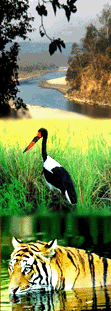 |
Corbett National Park:
|
|
Jim
Corbett National Park India is a haven for
Tigers as well as its prey, which include
four kinds of Deer, Wild Boar and some
lesser-known animals. Leopards are mostly
found in the hilly areas of the Corbett
park. Some nocturnal cats found here are the
Leopard Cat, Jungle Cat and Fishing Cat.
Sloth Bear is found in the lower regions of
the park while the Himalayan Black Bear is
seen in the higher hills only. The Dole or
Wild Dog, though they can be seen in the
southern areas of the park along with the
Jackal. Some of the smaller residents of the
park are Himalayan Palm Civet, Indian Gray
Mongoose, Common Otter, Blacknaped Hare and
Porcupine. Elephants are among one of the
main attractions of Jim Corbett Park. Along
the Ramganga River shores, one can spot the
long-snouted, fish-eating Gharial Crocodile
and the 'Mugger' Crocodile. Also seen on the
rocky hillsides is the Ghoral or Goat
Antelopes. The Langur and Rhesus Monkeys are
well distributed through out the jim corbett
national park and warning the whole Jungle
with alarm calls when they see either a
Tiger or Leopard from tree-top perches. Reference
.. .. .. |
|
 |
|
 |
Sikkim:
|
|
A
former kingdom , Sikkim is now the 22nd
State of India . It is rooted to the
Himalayan Massif like a scale on the neck of
a Dragon. The various ethnic groups have
their own nomenclature - the Nepalese call
it “Sukhim” or “New Home”, to the
Tibetans it is known as “Denzong” or
“the Valley of Rice”, and to the Lepchas,
Sikkim’s original inhabitants , it means
“Nye-Mal-Ale” or “Heaven”. The
state’s 64-km width is squeezed between
the mountainous kingdoms of Bhutan and Nepal
to the east and west respectively. The high
plateau of China’s province of Tibet lies
40-km to the north and India’s Bengal
state to the south. Within Sikkim’s 113-km
north - south delineation the altitude rises
steeply from 253m to 8,595 (800 ft to 28,199
ft) and encompass almost all the climatic
zones found on earth. Sikkim is divided into
four districts - East, West, North and
South. The most populated area is the
eastern district which contains the capital
town Gangtok, followed by the southern and
western districts , and finally the sparsely
populated northern area with its in hospital
climate and steep ridges. Reference
.. |
|
 |
|
 |
Kerala:
|
|
One
of the most idyllic states of India, lies to
the extreme southwest of Indian peninsula.
It is flanked by the Arabian Sea on the west
and the mountain ranges of the Western Ghats
on the east. The state can be divided into
hills, valleys, midland plains and coastal
belts. Formed in the year 1956, it has 14
districts with Thiruvananthapuram as its
capital. The economy of Keralais
primarily agrarian in nature. Some of the
key crops of Kerala are tea, coffee, rubber,
cashew, cardamom, pepper and cinnamon. Its
service sector is booming with financial
companies, real estate agencies, mortgage
companies, consultancy services, insurance
companies and tourism industry.
Kerala is quite advanced in terms of Human
Development Index and life standard. It
records the highest among states, on the
United Nations Development Programmer's
Human Development Index. In Kerala, the
number of people living below the poverty
line is around 25 percent, which is less
than the national average of 35 per cent.
Kerala has become one of the most sought
after tourist destinations in the country as
well as abroad. It is famous for its rivers,
backwaters and endless beaches. Besides,
ayurveda, unani and naturopathy have also
become quite popular among tourists,
national as well as international. Better
known as God's own country, kerala offers a
lot of tourist destinations. Some of the
famous tourist spots are Alleppey, Kochi,
Munnar, Palakkad, Varkala and Kozhikode. Reference.. |
|
 |
|
 |
Goa:
|
|
Variously
known as "Pearl of the Orient" and
a "Tourist Paradise", the state of
Goa is located on the western coast of India
in the coastal belt known as Konkan. The
magnificent scenic beauty and the
architectural splendours of its temples,
churches and old houses have made Goa a firm
favourite with travellers around the world.
But then, Goa is much more than just beaches
and sea. It has a soul which goes deep into
unique history, rich culture and some of the
prettiest natural scenery that India has to
offer. Much of the real Goa is in its
interiors, both inside its buildings and in
the hinterland away from the coastal area.
Legends from Hindu mythology credit Lord
Parshuram, an incarnation of Lord Vishnu
with the creation of Goa. Over the centuries
various dynasties have ruled Goa.
Rashtrakutas, Kadambas, Silaharas, Chalukyas,
Bahamani Muslims and most famously the
Portuguese have been rulers of Goa. Reference.. |
|
 |
|
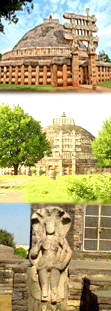 |
Sanchi: |
|
Sanchi stands in testimony to the golden Buddhist age of Emperor Ashoka. Today Sanchi is synonymous to the masterpieces of Buddhist art revealed in the age-old Stupas, monasteries, temples, and monolithic pillars. The monuments of Sanchi were built way back during the 3rd century BC to the 12th century AD.
The distance of Sanchi from the capital city of Madhya Pradesh, Bhopal is just 46 kilometers in the East, this makes the trip to the Sanchi a one day affair and extremely popular. Away from the hustle bustle that surrounds Bhopal Sanchi offers complete peace and tranquility. Sanchi is situated over a hillock and in the ancient times was addressed to as Kakanaya, Kakanava, Kakanadabota and
Bota-Sriparvata., . |
|
 |
|
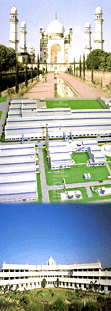 |
Aurangabad:
|
|
There
are a number of important tourist spots
beyond the city limits of Aurangabad. The
cave temples of Ellora, listed among the
World Heritage sites, are 30 km northwest of
the city. The world famous Buddhist caves at
Ajanta, also a World Heritage site, lies 166
km northeast of Aurangabad. The Buddhist
caves of Ajanta are world famous for their
well-preserved frescoes (wall paintings),
which vividly depict the lifestyle of that
period. The fortress of Daulatabad is 13 km
from Aurangabad and is situated en route
Ellora. Khuldabad, the last resting place of
Aurangzeb, is 3 km from Ellora. Grishneshwar
temple, an important Hindu pilgrim place, is
located in the village of Verul, near Ellora
caves. It is one of the twelve Jyotirlingas
of India, where Lord Shiva is worshipped.
Paithan, 56 km south of Aurangabad, is
famous for its traditional Paithani silk
saris. Twenty-four kilometers from
Aurangabad lie the Bani Begum Gardens, which
surround the tomb of one of Aurangzeb's
queens. Pithalkora caves are 78 km from
Aurangabad. Mhaismal, 25 km from Aurangabad,
is another tourist spot.
.. |
|
 |
|
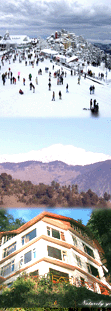 |
Shimla:
|
|
One
place people should never miss to go in
India is Shimla because of its scenery and
its snow. People who have been seeing hot
weather for months will really have a good
time in Shimla because of its snow. During
those October to March most of the time you
can see snow in the mountains, which is a
splendid view to watch and play. Chail,
which is 45 kilometers away from Shimla, is
known for its greenery. A wild life
sanctuary is also located in that place. You
can also find the palace in this place,
which is that of Maharaja of Patiala. This
palace is now converted into a hotel. During
winters chail greenery will be covered by
snow. Tattapani is known for its waters and
you can find people fishing in this spot.
Trees like Oak and Pine are a lot in Shimla.
One reason why people prefer Shimla is for
its greenery and snow. Reference
.. |
|
 |
|
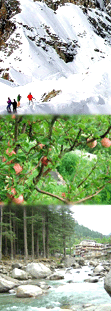 |
Manali:
|
|
Hadimba
or Dhungiri temple in Manali is one of the
most important temples in the region. This
four-story wooden temple is located in the
middle of a forest called the Dhungiri Van
Vihar. Winding paths through forests and
glades of whispering Deodars form the
setting for the majestic wooden temple of
Hidimba Devi in Manali. The motorable road
is shaded by Chestnuts, Chinars and tall
deciduous Deodars. This forested backdrop
enthrall one’s spirit and refresh one’s
mind all along the uphill path. Reference
.. |
|
 |
|
 |
Haridwar:
|
|
Har-Ki-Pauri,
the sacred ghat was constructed by King
Vikramaditya in the memory of his brother
Bhartrihari. The golden reflection of floral
diyas in the river Ganges is the most
enchanting sight in the twilight during the
Ganga aarti ceremony at the ghat. The temple
of Chandi Devi a top the Neel Parvat on the
other bank of river Ganges was constructed
in AD 1929 by Suchat Singh, the then King of
Kashmir. The temple is a 3-km trek from
Chandi Ghat and it is believed that the Adi
Shankaracharya established the main statue
in eighth century AD. The Chandi Devi Temple
is now also accessible by a ropeway, which
starts near the Gauri Shankar Temple. The
temple a top the Bilwa Parvat is dedicated
to Goddess Mansa Devi. One can have a
panoramic view of Haridwar, the Ganges, and
the countryside from this place.The Vaishno
Devi temple here is newly constructed and a
true replica of the original Vaishno Devi
temple in Jammu & Kashmir.The Gurukul
Kangadi University is a center of learning
where education is imparted in the
traditional Indian way. Within the precincts
of the University is the Veda Mandir, which
houses many archaeological exhibits. It is
situated on the Haridwar-Jwalapur bypass
road. Other important places to visit are
the Bharat Mata Temple, Maya Devi Temple,
Bhimgoda, and Shanti Kunj. Reference
.. |
|
 |
|
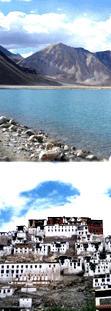 |
Ladakh:
|
|
Ladakh
is a land like no other. Bounded by two of
the world's mightiest mountain ranges, the
Great Himalaya and the Karakoram, it lies
athwart two other, the Ladakh range and the
Zanskar range. In geological terms, this is
a young land, formed only a few million
years ago by the buckling and folding of the
earth's crust as the Indian sub-continent
pushed with irresistible force against the
immovable mass of Asia. Its basic contours,
uplifted by these unimaginable tectonic
movements, have been modified over the
millennia by the opposite process of
erosion, sculpted into the form we see today
by wind and water. Reference.. |
|
 |
|
